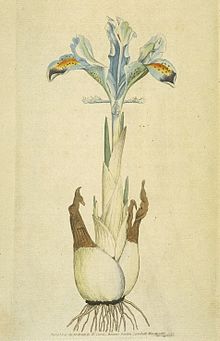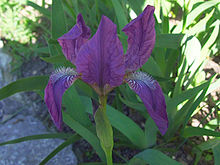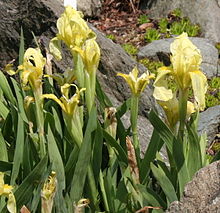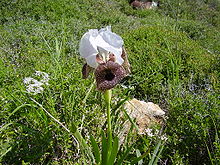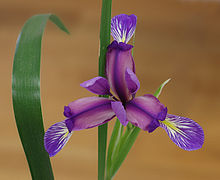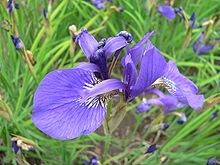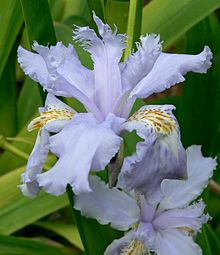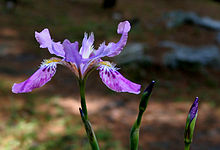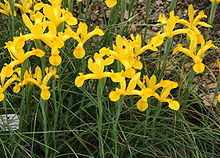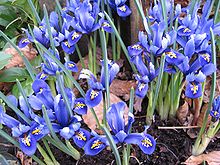- Iris (plant)
-
This article is about the Iris plant. For other uses, see Iris (disambiguation).
Iris 
Blood Iris (Iris sanguinea),
known as ayame in JapanScientific classification Kingdom: Plantae Division: Magnoliophyta (unranked): Monocots Order: Asparagales Family: Iridaceae Subfamily: Iridoideae Tribe: Irideae Genus: Iris
L.Type species Iris germanica
L.Subgenera Hermodactyloides
Iris
Limniris
Nepalensis
Scorpiris
XiphiumSynonyms Iridodictyum
Juno
Junopsis
XiphionIris is a genus of 260 [1] -300 [2] species of flowering plants with showy flowers. It takes its name from the Greek word for a rainbow, referring to the wide variety of flower colors found among the many species.[3] As well as being the scientific name, iris is also very widely used as a common name for all Iris species, though some plants called thus belong to other closely related genera. A common name for some species is 'flags', while the plants of the subgenus Scorpiris are widely known as 'junos', particularly in horticulture. It is a popular garden flower.
The genera Belamcanda (blackberry lily), Hermodactylus (snake's head iris), Neomarica (walking iris) and Pardanthopsis are sometimes included in Iris.
Contents
Description
The genus is widely distributed throughout the north temperate zone. Their habitats are considerably varied, ranging from cold and montane regions to the grassy slopes, meadowlands and riverbanks of Europe, the Middle East and northern Africa, Asia and across North America.
Irises are perennial herbs, growing from creeping rhizomes (rhizomatous irises), or, in drier climates, from bulbs (bulbous irises). They have long, erect flowering stems, which may be simple or branched, solid or hollow, and flattened or have a circular cross-section. The rhizomatous species usually have 3–10 basal, sword-shaped leaves growing in dense clumps. The bulbous species have cylindrical, basal leaves.
The inflorescences are fan-shaped and contain one or more symmetrical six-lobed flowers. These grow on a pedicel or lack a footstalk. The three sepals, which are spreading or droop downwards, are referred to as "falls". They expand from their narrow base, which in some of the rhizomatous irises has a "beard" (a tuft of short upright extensions growing in its midline), into a broader expanded portion ("limb"), often adorned with veining, lines or dots. The three, sometimes reduced, petals stand upright, partly behind the sepal bases. They are called "standards". Some smaller iris species have all six lobes pointing straight outwards, but generally, limb and standards differ markedly in appearance. They are united at their base into a floral tube that lies above the ovary (known as an inferior ovary). The styles divide towards the apex into petaloid branches; this is significant in pollination.
The iris flower is of special interest as an example of the relation between flowering plants and pollinating insects. The shape of the flower and the position of the pollen-receiving and stigmatic surfaces on the outer petals form a landing-stage for a flying insect, which in probing the perianth for nectar, will first come in contact of perianth, then with the stigmatic stamens in one whorled surface which is borne on an ovary formed of three carpels. The shelf-like transverse projection on the inner whorled underside of the stamens is beneath the over-arching style arm below the stigma, so that the insect comes in contact with its pollen-covered surface only after passing the stigma; in backing out of the flower it will come in contact only with the non-receptive lower face of the stigma. Thus, an insect bearing pollen from one flower will, in entering a second, deposit the pollen on the stigma; in backing out of a flower, the pollen which it bears will not be rubbed off on the stigma of the same flower.
The iris fruit is a capsule which opens up in three parts to reveal the numerous seeds within. In some species, these bear an aril.
Systematics and taxonomy
Up to 300 species – many of them natural hybrids – have been placed in the genus Iris. Modern classifications, starting with W. R. Dykes' 1913 book, have subdivided them. Dykes referred to the major subgroupings as sections, but later authors have generally called them subgenera, while essentially retaining his groupings. Like some older sources, the influential classification by G. I. Rodionenko removed some groups (particularly the bulbous irises) to separate genera, but even if this is done the genus remains large and several subgenera, sections and/or subsections are recognised within it.[4]
In general, modern classifications usually recognise six subgenera, of which five are restricted to the Old World; the sixth (subgenus Limniris) has a Holarctic distribution. The two largest subgenera are further divided into sections.
Subgenus Iris
Bearded rhizomatous irises
Section Iris
- Iris albertii
- Iris albicans – White Cemetery Iris, White Flag Iris
- Iris amoena DC. (= I. variegata?)
- Iris aphylla L. – Stool Iris (including I. benacensis, I. nudicaulis)
- Iris attica (Boiss. & Heldr.) Hayek
- Iris × buriensis Lem.
- Iris croatica
- Iris cypriana Foster & Baker
- Iris flavescens Delile – Lemon-yellow Iris (= I. variegata?)
- Iris furcata Bieb.
- Iris germanica L. – German Iris (includes I. × barbata)
- Iris × germanica nothovar. florentina Dykes
- Iris glaucescens Bunge
- Iris glockiana O.Schwarz
- Iris illyrica (often included in I. pallida)
- Iris imbricata Lindl.
- Iris junonia Schott ex Kotschy
- Iris × lurida Aiton (I. pallida × I. variegata, including I. neglecta, I. squalens)
- Iris lutescens Lam. (including I. italica)
- Iris marsica I.Ricci & Colas.
- Iris mesopotamica – Mesopotamian Iris
- Iris orjenii – Orjen Iris
- Iris pallida – Sweet Iris, Dalmatian Iris
- Iris perrieri Simonet ex P.Fourn.
- Iris pseudopumila Tineo
- Iris pumila L.
- Iris purpureobractea B.Mathew & T.Baytop
- Iris reichenbachii Heuff. – Reichenbach's Iris
- Iris sambucina L.
- Iris scariosa Willd. ex Link
- Iris schachtii Markgr.
- Iris suaveolens Boiss. & Reut. (including I. iliensis)
- Iris subbiflora Brot.
- Iris taochia Woronow ex Grossh.
- Iris timofejewii Woronow
- Iris variegata L. – Hungarian Iris
Section Oncocyclus
- Iris acutiloba C.A.Mey. (including I. ewbankiana)
- Iris assadiana Chaudhary, Kirkw. & C.Weymolauth
- Iris atrofusca Bak.
- Iris atropurpurea Bak.
- Iris barnumae Bak. & Fost.
- Iris bismarckiana Reg. – Nazareth Iris
- Iris camillae Grossh.
- Iris gatesii Foster
- Iris haynei (Bak.) Mallet. – Gilboa Iris
- Iris hermona Dinsmore – Hermon Iris
- Iris iberica Hoffm.
- Iris kirkwoodi (including I. calcarea)
- Iris lortetii Barbey ex Boiss.
- Iris mariae Barbey.
- Iris meda Stapf
- Iris paradoxa Steven
- Iris petrana Dinsm.
- Iris polakii Stapf
- Iris sari Schott ex Bak.
- Iris sofarana Fost.
- Iris susiana L. – Mourning Iris
Section Hexapogon
- Iris falcifolia Bunge
- Iris longiscapa Ledeb.
Section Psammiris
- Iris bloudowii Ledeb.
- Iris humilis Georgi
- Iris kamelinii Alexeeva
- Iris mandschurica Maxim.
- Iris potaninii Maxim.
- Iris vorobievii N.S.Pavlova
Section Pseudoregelia
- Iris goniocarpa Bak.
- Iris hookeriana Fost.
- Iris kamaonensis Wall.
- Iris sikkimensis Dykes
- Iris tigrida Bunge ex Ledeb.
Section Regelia
- Iris hoogiana Dykes
- Iris korolkowii Regel
- Iris stolonifera Maxim.
Subgenus Limniris
Beardless rhizomatous irises
Section Limniris
- Iris acoroides Spach
- Iris bracteata – Siskiyou Iris
- Iris brevicaulis Raf. – Zigzag Iris
- Iris bulleyana Dykes
- Iris caespitosa Pall. & Link
- Iris chrysographes – Black Iris
- Iris chrysophylla – Yellow-leaved Iris
- Iris clarkei Bak.
- Iris crocea Jacquem. ex R.C.Foster (including I. aurea)
- Iris delavayi Micheli
- Iris demetrii Achv. & Mirzoeva
- Iris douglasiana – Douglas Iris
- Iris ensata Thunb. – Japanese Iris, hanashōbu (Japanese) (including I. kaempferi)
- Iris fernaldii – Fernald's Iris
- Iris foetidissima – Stinking Iris, Gladwin Iris, Stinking Gladwin, Gladdon, Roast-beef Plant
- Iris forrestii Dykes
- Iris fulva Ker-Gawl. – Copper Iris
- Iris giganticaerulea – Giant Blue Iris, Giant Blue Flag
- Iris graminea L.
- Iris grant-duffii Bak.
- Iris hartwegii – Hartweg's Iris, Rainbow Iris, Sierra Iris
- Iris hexagona Walt. – Dixie Iris
- Iris hookeri Penny – Hooker's Iris
- Iris innominata – Del Norte Iris
- Iris kerneriana Asch. & Sint.
- Iris koreana Nakai
- Iris lactea Pall.
- Iris laevigata – Rabbitear Iris, Shallow-flowered Iris, kakitsubata (Japanese)
- Iris lazica Albov
- Iris loczyi Kanitz
- Iris longipetala Herb.
- Iris lorea Jank.
- Iris ludwigii Maxim.
- Iris maackii Maxim.
- Iris macrosiphon – Bowltube Iris
- Iris missouriensis – Rocky Mountain Iris, Western Blue Flag
- Iris monnieri DC.
- Iris munzii – Munz's Iris, Tulare Lavender Iris
- Iris nelsonii Randolph – Abbeville Iris
- Iris notha M.Bieb.
- Iris orientalis Mill. – Yellow-banded Iris
- Iris pontica Zapal.
- Iris prismatica Pursh ex Ker-Gawl. – Slender Blue Flag
- Iris pseudacorus – Yellow Iris, Yellow Flag
- Iris purdyi – Purdy's Iris
- Iris × robusta E.Anders. – Robust Iris (I. versicolor × I. virginica)
- Iris ruthenica Ker-Gawl.
- Iris × sancti-cyri Rouss. – Sanctimonious Iris[verification needed] (I. hookeri × I. versicolor)
- Iris sanguinea Hornem. ex Donn – Blood Iris, ayame (Japanese)
- Iris setosa Pallas ex Link – Beachhead Iris
- Iris sibirica – Siberian Iris
- Iris sintenisii Janka
- Iris sintenisii ssp. brandzae Prodan
- Iris songarica Schrenk
- Iris spuria – Blue Iris
- Iris spuria ssp. maritima – Seashore Iris
- Iris tenax – Tough-leaved Iris, Oregon Iris
- Iris tenuifolia Pall.
- Iris tenuissima Dykes – Long-tubed Iris
- Iris thompsonii R.C.Foster – Thompson's Iris (formerly in I. innominata)
- Iris tridentata Pursh – Savanna Iris
- Iris unguicularis Poir. (including I. speciosa, I. stylosa)
- Iris uniflora Pall.
- Iris ventricosa Pall.
- Iris verna L. – Dwarf Violet Iris
- Iris versicolor – Larger Blue Flag, Harlequin Blueflag
- Iris × vinicolor Small – Vinicolor Iris, Wine-coloured Iris (I. fulva × I. giganticaerulea)
- Iris virginica L. – Virginia Iris
- Iris wilsonii C.H.Wright
Section Lophiris
- Iris confusa – Bamboo Iris
- Iris cristata – Crested Iris
- Iris gracilipes A.Gray
- Iris japonica Thunb.
- Iris lacustris – Dwarf Lake Iris
- Iris milesii Foster
- Iris tectorum Maxim. – Wall Iris
- Iris tenuis S.Wats. – Clackamas Iris
- Iris wattii Baker ex Hook.f.
Subgenus Xiphium
Smooth-bulbed bulbous irises. Formerly genus Xiphion.
Section Xiphium
- Iris boissieri Henriq
- Iris filifolia Boiss.
- Iris juncea Poir.
- Iris latifolia – English Iris
- Iris serotina Willk. in Willk. & Lange
- Iris tingitana Boiss. & Reut. – Morocco Iris
- Iris xiphium syn. Iris x hollandica[5] – Spanish Iris, Dutch Iris, Small Bulbous-rooted Iris
Subgenus Nepalensis
Bulbous irises. Formerly genus Junopsis.
Section Nepalensis
- Iris collettii Hook.
- Iris decora Wall.
Subgenus Scorpiris
Smooth-bulbed bulbous irises known as "junos". Formerly genus Juno.
Section Scorpiris
- Iris albomarginata R.C.Foster
- Iris aucheri (Baker) Sealy (including I. sindjarensis)
- Iris bucharica Foster
- Iris caucasica Hoffm.
- Iris cycloglossa Wendelbo
- Iris fosteriana Aitch. & Baker
- Iris graeberiana Tubergen ex Sealy
- Iris magnifica Vved.
- Iris narynensis O.Fedtsch.
- Iris nusairiensis Monterode
- Iris palaestina (Bak.) Boiss.
- Iris persica L.
- Iris planifolia (Mill.) Fiori & Paol.
- Iris pseudocaucasica Grossh.
- Iris regis-uzziae Feinbrun
- Iris rosenbachiana Reg.
- Iris vicaria Vved.
Subgenus Hermodactyloides
Reticulate-bulbed bulbous irises. Formerly genus Iridodictyum.
Section Hermodactyloides
- Iris bakeriana Foster
- Iris danfordiae (Baker) Boiss.
- Iris histrio Rchb.f.
- Iris histrioides (G.F.Wilson) S.Arn.
- Iris kolpakowskiana Regel
- Iris pamphylica Hedge
- Iris reticulata Bieb.
- Iris tuberosa L.
- formerly Hermodactylus tuberosus
- Iris vartanii Fost.
- Iris winogradowii Fomin
Uses
In horticulture
Irises are extensively grown as ornamental plants in home and botanical gardens. Presby Memorial Iris Gardens in New Jersey, for example, is a living iris museum with over 10,000 plants, while in Europe the most famous iris garden is arguably the Giardino dell'Iris in Florence (Italy) which every year hosts one of the most famous iris breeders' competitions in the world.
Bearded rhizomatous (subgenus Iris) irises
The most commonly found garden iris is the bearded German Iris (I. germanica), a hybridogenic species, and its numerous cultivars. Various wild forms and naturally occurring hybrids of the Sweet Iris (I. pallida) and the Hungarian Iris (I. variegata) form the basis of most all modern hybrid bearded irises. Median forms of bearded iris (intermediate bearded, or IB; miniature tall bearded, or MTB; etc.) are derived from crosses between tall and dwarf varieties.
The bearded irises are easy to cultivate and propagate, and have become very popular in gardens. They grow in any good free garden soil, the smaller and more delicate species needing only the aid of turf ingredients, either peat or loam, to keep it light and open in texture. The earliest to bloom are species like I. junonia and I. reichenbachii, which flower as early as February and March, followed by the dwarf forms of I. pumila which blossom during March, April and May. During the latter month and the following one, most of the larger-growing "tall bearded" irises bloom, such as the German Iris and its variety florentina, Sweet Iris, Hungarian Iris, Lemon-yellow Iris (I. flavescens), Iris sambucina, I. amoena, and their natural and horticultural hybrids such as those described under names like I. neglecta or I. squalens and best united unter I. × lurida.
The section Oncocyclus contains the cushion irises or royal irises, a group of plants noted for their large, strongly marked flowers. Between 30 and 60 species are classified in this section, depending on the authority. Compared with other irises the cushion varieties are scantily furnished with narrow sickle-shaped leaves and the flowers are usually borne singly on the stalks; they are often very dark and in some almost blackish. The cushion irises are somewhat fastidious growers, and to be successful with them they must be planted rather shallow in very gritty well-drained soil. They should not be disturbed in the autumn, and after the leaves have withered the roots should be protected from heavy rains until growth starts again naturally.
The section Regelia, closely allied to the cushion irises, includes several garden hybrids with species in section Oncocyclus, known as Regelio-cyclus irises. They are best planted in September or October in warm sunny positions, the rhizomes being lifted the following July after the leaves have withered.
A truly red bearded iris remains an unattained goal despite frequent hybridizing and selection. There are species and selections, most notably based on the beardless rhizomatous Copper Iris (I. fulva), which have a relatively pure red color. However, getting this color into a modern bearded iris breed has proven very difficult, and thus, the vast majority of irises are in the purple and blue range of the color spectrum, with yellow and whitish breeds also quite frequent.
Beardless rhizomatous (subgenus Limneris) irises
Beardless rhizomatous iris types commonly found in the garden are the Siberian Iris (I. sibirica) and its hybrids, and the Japanese Iris (I. ensata) and its hybrids. "Japanese Iris" is also a catch-all term for the Japanese Iris proper (hanashōbu), the Blood Iris (I. sanguinea, ayame) and the Rabbitear Iris (I. laevigata, kakitsubata). I. unguicularis is a late-winter-flowering species from Algeria, with sky-blue flowers blotched with yellow, produced (in the Northern Hemisphere) from November to March or April. Yet another beardless rhizomatous iris popular in gardening is I. ruthenica, which has much the same requirements and characteristics as the "tall bearded" irises.
Reticulate-bulbed (subgenus Hermodactyloides) irises
"Reticulate" irises with their characteristic bulbs, including th e yellow I. danfordiae, and the various blue-purple I. histrioides, I. reticulata, as well as the smooth-bulbed I. filifolia, flower as early as February and March. These reticulate-bulbed irises are miniatures and popular spring bulbs, being one of the first to bloom in the garden. Many of the smaller species of bulbous iris, being liable to perish from excess of moisture, should have a well-drained bed of good but porous soil made up for them, in some sunny spot, and in winter should be protected by a covering of half-decayed leaves or fresh cocos-fibre refuse.
-
Iris pseudacorus in Cheshire in England
Aromatic rhizomes
Rhizomes of the German Iris (I. germanica) and Sweet Iris (I. pallida) are traded as orris root and are used in perfume and medicine, though more common in ancient times than today. Today Iris essential oil (absolute) from flowers are sometimes used in aromatherapy as sedative medicines. The dried rhizomes are also given whole to babies to help in teething. Gin brands such as Bombay Sapphire and Magellan Gin use orris root and sometimes iris flowers for flavor and color.
For orris root production, iris rhizomes are harvested, dried, and aged for up to 5 years. In this time, the fats and oils inside the roots undergo degradation and oxidation, which produces many fragrant compounds that are valuable in perfumery. The scent is said to be similar to violets. The aged rhizomes are steam-distilled which produces a thick oily compound, known in the perfume industry as "iris butter".
Iris rhizomes also contain notable amounts of terpenes, and organic acids such as ascorbic acid, myristic acid, tridecylenic acid and undecylenic acid. Iris rhizomes can be toxic. Larger Blue Flag (I. versicolor) and other species often grown in gardens and widely hybridized contain elevated amounts of the toxic glycoside iridin. These rhizomes can cause nausea, vomiting, diarrhea, and/or skin irritation, but poisonings are not normally fatal. Irises should only be used medicinally under professional guidance.
Medical uses
Iris pallasii Fisch. var. Chinensis Fisch is the source of the anti-cancer principle "Irisquinone" effective against U14 and Lymph sarcoma and some other cancers.[6]
In water purification
In water purification, Yellow Iris (I. pseudacorus) is used. The roots are usually planted in a substrate (e.g. lava-stone) in a reedbed-setup. The roots then improve water quality by consuming nutrient pollutants, such as from agricultural runoff.
In art and symbolism
An iris – species unspecified – is one of the state flowers of Tennessee. Tradition holds that the particular iris symbolizing Tennessee is a purple cultivar, to go alongside the wild-growing Purple Passion Flower (Passiflora incarnata) which is the state's other floral emblem. Greeneville, Tennessee is home to the annual Iris Festival celebrating the Iris, local customs, and culture.[7]
The artist George Gessert has specialised in breeding irises.[8]
The artist Vincent van Gogh painted several famous pictures of irises.[9]
The American artist, Joseph Mason — a great friend of John James Audubon — painted a precise image of what was then known as the Lousianna Flag or Copper Iris (Iris cuprea) to which Audubon subsequently added two Northern Paraula birds (parula americana) for inclusion as Plate 15 in his Birds of America.
The artist Philip Hermogenes Calderon painted an iris in his 1856 work Broken Vows; he followed the principles of the Pre-Raphaelite Brotherhood. An ancient belief is that the iris serves as a warning to be heeded, as it was named for the messenger of Olympus. It also conveys images of lost love and silent grief, for young girls were led into the afterlife by Iris. Broken Vows was accompanied with poetry by Henry Wadsworth Longfellow when it was first exhibited.[10]
The fleur-de-lis, a stylized iris, first occurs in its modern use as the emblem of the House of Capet. The fleur-de-lis has been associated with France as Louis VII adopted it as a symbol in the 12th Century. The yellow fleur-de-lis reflects the Yellow Iris (I. pseudacorus), common in Western Europe. Contemporary uses can be seen in the Quebec flag and the logo of the New Orleans Saints professional football team, and on the flag of Saint Louis, Missouri.
The red fleur-de-lis in the coat-of-arms of Florence (Italy) descends from the white iris which is native to Florence and which grew even in its city walls. This white iris, displayed against a red background, became the symbol of Florence until the Medici family, to signal a change in political power, reversed the colors making the white one red and setting in motion a centuries-long breeding program to hybridize a red iris.
Furthermore, the fleur-de-lis is the almost-universal symbol of Scouting and one of the symbols adopted by the sorority, Kappa Kappa Gamma.
A stylized Yellow Iris is the symbol of Brussels, since historically, the important Saint Gaugericus Island was carpeted in them.[11] The iris symbol is now the sole feature on the flag of the Brussels-Capital Region.
The provincial flower of Québec (Canada) is the Harlequin Blueflag (I. versicolor), called iris versicolore in French.-
Philip Hermogenes Calderon's Broken Vows with the iris at lower left
-
Coat-of-arms of the House of Capet
-
Coat of Arms of Ukraine is a stylized iris[verification needed], a symbol of the Perun (thunder god) from the pagan antiquity.
See also
References
- ^ "WCSP". World Checklist of Selected Plant Families. http://apps.kew.org/wcsp/. Retrieved 2010.
- ^ Pacific Bulb Society: Iris
- ^ Manning, John; Goldblatt, Peter (2008). The Iris Family: Natural History & Classification. Portland, Oregon: Timber Press. pp. 200–204. ISBN 0-88192-897-6.
- ^ Dyke (1913), Rodionenko (1961)
- ^ Uniprot: Iris hollandica
- ^ John A. Hadfield, Alan T. McGown and John Butler., "A High-Yielding Synthesis of the Naturally Occurring Antitumour Agent Irisquinone" Molecules 2000, 5(1), 82-88; doi:10.3390/50100082 Open access http://www.mdpi.com/1420-3049/5/1/82/
- ^ http://www.greenecountypartnership.com/iris_festival.aspx
- ^ West [2008]
- ^ Pioch (2002)
- ^ Mancoff (2003): p.6,16
- ^ CPM-KB [2007]
- Chancery of the Prime Minister, Kingdom of Belgium (CPM-KB) [2007]: Brussels Town Hall. Retrieved 2007-NOV-11.
- Dykes, W.R. (1913): The genus Iris. Cambridge University Press, Cambridge, UK.
- Mancoff, Debra N. (2003): Flora Symbolica: Flowers in Pre-Raphaelite Art. Prestel Publishing, New York, USA. ISBN 3-7913-2851-4
- Pioch, Nicolas (2002): Gogh, Vincent van: Irises. Bersion of 2002-AUG-19. Retrieved 2008-DEC-10.
- Rodionenko, G.I. (1961): The genus Iris L.. Moscow and Leningrad.
- Species Group of the British Iris Society (1996): A Guide to Species Irises: Their Identification and Cultivation; Cambridge University Press, Cambridge, UK. ISBN 0-521-44074-2
- West, Ruth [2008]: George Gessert. Retrieved 2008-DEC-10.
External links
- Joseph Mason's painting - Copper Iris Copper Iris / Louisiana Flag (Iris cuprea) from John James Audubon's Birds of America
- WCSP, World Checklist: Iris
- Flora of North America: Iris
- Flora of China: Iris
- Flora of Pakistan: Iris
- Flora of Nepal: Iris
- Iris Species
- A web site devoted to Irises, by David Payne-Joyce; includes plates from Dykes (1913).
- The American Iris Society
- Iris taxonomy in GBIF Biodiversity Data Portal
- Historic Iris Preservation Society
- Iris listings at Wild Flowers of Israel
- Bearded Iris colors
- Iris in Art and Culture
- Gouvernement du Québec Emblèmes du Québec - Iris versicolor (French)
Categories:- Iridaceae genera
Wikimedia Foundation. 2010.


